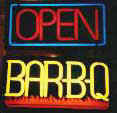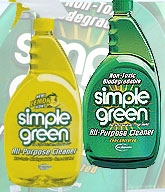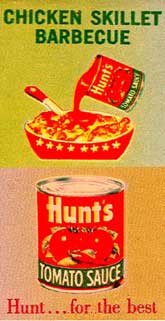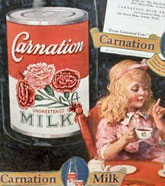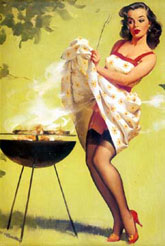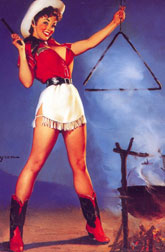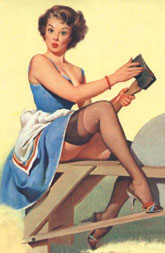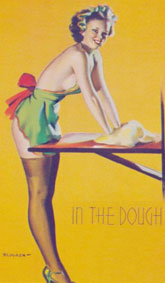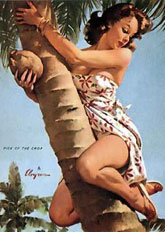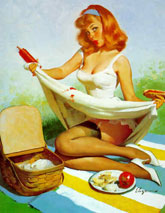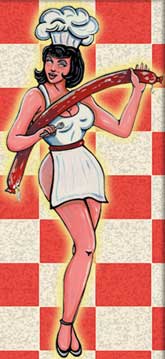Contact BBQbyDan
www.BBQDan.com
Search
KCBS BBQ Cook-Off Info
Recipes,
Smoking Meats
Recipes, Grilling
|
|
|
|
One of the first things you need to do is decide what type of Pork Rib (spare or back) you want to use. I personally prefer spare ribs myself for pure great meaty taste. However, Back (baby-back) are fantastic also.. I like spares because it is what I started using and learned on, they seem meatier, they are cheaper, and are what I am accustomed to. I have won many awards using spare ribs against competitors who have used back ribs.
When I said I spare's are cheaper that does have a caveat. I cook my spares St. Louis style. In other words I cut the brisket bone off and the skirt. And, sometimes I just throw the trimmed pieces away. Thus, are they really cheaper? Anyway, after the spare is trimmed it looks very much like a back rib but the bones are not as curved. In fact, Bill Wight, who states he prefers backs better than spares, once was tasting my left-over's from a contest and said this was a VERY VERY good rib. I said, but Bill, you are a "back" type guy! He said, well these are backs! I said no, these were St. Louis spares, he was incredulous and unbelieving... The point is one can trim and cook a spare to look and taste exactly like a back rib. But, back to the point of cost and expense on spares versus backs. When you buy a back for typically $3.99 per pound you have no waste or trimmings to speak of. When you buy a spare for $1.99 per pound you have the brisket bone and skirt meat as left-over trimmings if you cut St. Louis style, which I do. These trimmings are great to cook while you are doing you spares. They only take about 2 hours and are good pre-dinner snacks. But, if you are doing 10 or 20 racks of spares the trimmings can be more trouble to cook than they are worth, take up valuable cooker shelf real-estate, and are not what the customer paid for. Also, at a contest there is no time to deal with them so I just toss them. There, I probably tossed the difference in price when I could have got backs instead and had no trimmings. However, backs cook and taste differently, so I still buy spares. So, take all the above into consideration when you decide what rib product you want to purchase and cook.
Reference to trimming I like, as I said previously, to use spares cut in the St. Louis Style. This basically means that the brisket bone and skirt are removed. But, my method is the following:
- Remove from package and immediately remove the membrane on the back side of the ribs. This is easier to remove with the rib rack in an un-trimmed state versus trimmed for me. I just use a sharp object (screwdriver, fork, knife, my trusty finger nail, or whatever) and get under the membrane about the 3rd bone up from the large side, then get my finger under it, then grip it with a paper towel and try to remove it in one full piece. That only happens about 1 out of 2 times. The butcher usually has sliced the membrane somewhere along the line and it rips as a result. The premise of membrane removal is it will be chewy after cooking and won't allow seasoning penetration. Some say the down side is it allows moisture to leave the rib. I still remove it.
- Remove any obvious and obnoxious fat. I don't get to anal about this however, so just do what pleases you.
- It is now time to cut off the brisket bone. I simply lay the rack parallel to my cutting board (long ways) and then cut off the brisket side in a parallel, but same, distance from opposite end (about 6-7 inches) throughout the entire rack. Now you spares look like backs. Trim the small end of the rack for a raggedy end if necessary.
- Cut off the skirt. This is the small extending piece of meat, by about 1 - 2 inches, off the underside of the spare.
- There is always a fat cap on one end of the spares rack. If that appears to need removal (as in a big, thick cap) I will do so. If it seems more appropriate to leave it in place, I do so.
All meat trimming and preparations are complete
Seasoning of either backs or spares at this point is a very simple and easy task. I choose not to marinade my ribs. I have never found a benefit that I felt was worth the effort. That is not say there is not a great marinade that would make a rib taste better. I just found that proper preparation, seasonings, cooking , marinating, and glazing can produce a rib that could take 1st place in the state without a long marinating period.
So, bottom line is I just lay the ribs all out, meat side down. Take mustard (just plain mustard) and LIGHTLY coat all the racks. Then I take my 5 Star BBQbyDan BBQ Rub and sprinkle all the racks LIGHTLY. Turn them over and repeat the process. In the end the ribs are meat side up and seasoned on both sides. They are now ready to put into the Smoker.
If you have the cooking space just put them in the cooker meat side up. If there are 20 - 30 racks, then put them in rib racks. Just pick a nice spot that has even heating (about 245 - 250) and go for it. I will typically cook ribs with pecan or 80% oak and 20% hickory. Pecan and Oak is easier to come by in California. Hickory is harder. Neither is as easy, or cheap, as mesquite to come by. Oak is not as strong of a smoke flavoring. Hickory is a stronger flavoring wood. I do not use mesquite on ribs. Ribs are the kind of meat that you are eating as much, or more, of the exposed meat during the cooking period time as what is not exposed. This is the opposite of brisket or butt where most of the content of what you are eating was NOT exposed to the smoke. So, for that reason I will cook my butts, briskets, Tritip, and prime rib with mesquite as a last option. Why even mess with a stouter wood like mesquite one might ask. Well, here in California they sell it in every store out there in 5 - 40 pound bags VERY cheap. Oak and Hickory is hard and expensive to come by. Also, I actually don't mind mesquite on my butt and brisket, but NOT my chicken or ribs. We are probably talking a 3 1/2 hour (backs) back and 4 1/2 hour (spares) cook-time. I would rotate and baste them the first time at 2 hours. Rotate them end-over-end, side-over-side (turn over), upper to lower shelf if applicable, and side-to-side (shelf positioning) if applicable. Of course if you have a rotisserie smoker forget all the rotations.
There is a definite difference in the way the two types of pork ribs are cooked. But, not that much different also. Basically the back is a more delicate rib. Only in terms of time. A spare with a lot of basting and with the final glaze might take 4 - 5 hours at 240 - 245. The back might take 3 1/2 - 4 hours at 240 - 245. Check for the "break" in the meat to ensure correct doneness. That is when you can reach in and twist the 3rd or 4th bones in and have them break versus bend, you are there.
There are lots of people that will marinate their pork ribs. This is probably a good thing. I however do not for multiple reasons. I instead take the approach that I want to open the package, trim, and season as close to the time that I put the meat on the smoker. This is just a personal preference. I also feel that my approach will provide you with the BEST ribs you have ever had. Very much award winning. The only items we get more awards and trophies for than my ribs would be chicken. But, we do very well in both. So, bottom line is I don't marinade, others do. That is fine. Try both and then decide which method works best for you.
Here in California glazing is almost mandatory. We are a state of "sticky, sweet, and gooey" on our pork rib products. Now, if you were in Texas or maybe Kansas City MO, it would be a different story. You might not glaze, and if you did it might not be sticky and gooey. Hey, sticky and gooey is fine with me. While in California do as the Californians do! Since most glazes (BBQ Sauces) have bunches of sugar I wait until the last 30 minutes to put my glaze on. So, when the ribs break I pull them out, glaze, then put them back in for 30 minutes. After that 30 minutes period they are done.
The final product is going to be the BEST ribs you have every had. Whether you used backs or spares. REMEMBER, moisture is the key to good ribs. If prepared and cooked correctly, they will be moist. If you follow the guidelines above your ribs will come out tasty, moist, and great.
Dan Cannon
|
|
|
|
|
|
|

